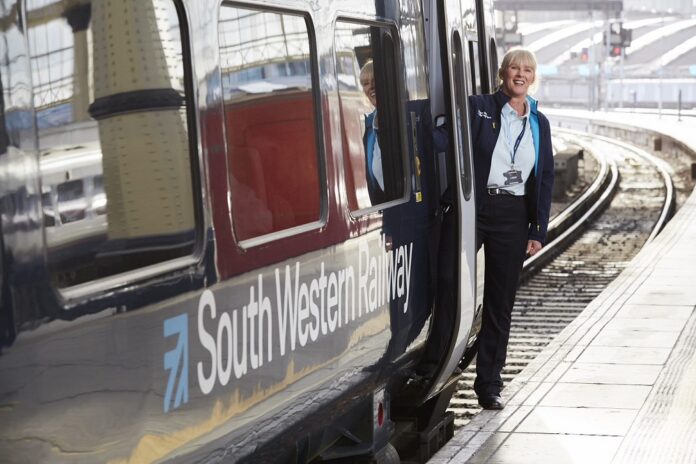Dressing the rail sector presents a unique challenge, today more than ever. With an increasingly diverse, multi-skilled workforce to cater for, and changing conditions to consider, workwear suppliers can’t adopt a one-size-fits-all approach.
Done right, uniforms boost employee morale, helping them to feel comfortable, professional, and part of a team. They also build brand awareness and improve customer experience.
It’s something Jermyn Street Design (JSD) feels strongly about. Founded 40 years ago in London, the bespoke uniform supplier has dressed staff for Great Western Railway, South Western Rail, and even Eurostar. Senior account manager Jo Fornear and commercial director Ann Dowdeswell spoke exclusively to Rail Business Daily, outlining the challenges of designing for the rail industry – and the benefits a well-made uniform can offer.
Design, functionality, and performance
For JSD, one of the most significant challenges is designing uniforms that will work well in a range of environments.
“A lot of railway staff have to work in very different environments,” Jo explained. “Some people will be out on the platform in all types of weather, from blistering heat in summer to freezing cold in winter.
Then there are people working in the ticket offices, or on-board trains. You even have different environments in different locations; some railways are undercover and quite protected, whereas other stations are very open to the elements.”
When designing rail workwear, JSD must take changing weather conditions into account, ensuring that garments perform well come rain or shine. This often involves working with fit-for-purpose fabrics.
“We also have to provide a range of uniforms that will suit all the different roles staff are carrying out,” Jo added. “To add to the complexity, some employees have dual roles; they might be public-facing on the platform, and take on cleaning duties later.”
To ensure that they meet their clients’ needs, JSD designers often carry out onsite research, spending the day with railway staff.
“We live a day in their life to see what they’re experiencing,” Ann explained. “We’ll find out what they’re carrying; is it a key holder on their belt, or a ticket machine that is worn over their shoulder? Are they pushing a trolley, or a driver in an oily environment?”
These insights enable JSD to design versatile, bespoke uniforms, suitable for a range of team members.
“We put a flag pocket in one coat, as some members of staff needed to carry one,” Ann remembered. “Because we were making coats for everyone, we accommodated that, along with pen pockets, zip out thermal layers and hidden radio loops.”
Sizing and performance are equally important, often making or breaking a new uniform range.
“If something is ill-fitting or not gender neutral, or if it doesn’t accommodate someone who’s transitioning or someone who has an allergy, it won’t work,” Ann concluded. “We have to take a holistic approach, ensuring that we cater for everyone.”
Rollout process
Rolling out these new uniforms is a lengthy and complex process, involving both unions and the Department for Transport.
“Another challenge is that railways are very union-guided,” Jo explained. “We like to pass any change of uniform through the unions to ensure that they’re happy with it.”
The involvement of the Department for Transport (DfT) (through which all direct awards must now pass) has caused further complications.
“Whereas Train Operating Companies (TOCS) used to be able to make independent decisions if they wanted to upgrade something in their uniform, they now have to go to the DfT for a budget to be signed off. This makes the process lengthier and more restrictive,” Ann added.
Building a brand
While significant, these challenges are far outweighed by the benefits of introducing a uniform range. Indeed, for rail employees, they can be a source of real pride.
“They feel proud in their job, and it’s often multi-generational, with several members of the family working in the industry,” Jo observed. “And if they have a good uniform that they like to wear, then that makes them feel even prouder. They also feel part of a team”
Well-designed workwear can also help TOCS to build their brand, reflecting who they are and what they do. JSD’s work for Eurostar is a case in point; its designers used custom fabrics and signature colours to create a uniform that strengthened the already iconic brand.
Better customer experience
From a practical perspective, uniforms also make rail staff more recognisable and accessible.
“Uniforms help to build trust with passengers,” Jo said. “If they know the brand and recognise the people who are working there, the general public will feel comfortable going up and asking them questions. Staff can then give help and guidance.”
Ultimately, Ann is clear about the importance of uniforms in the rail industry, concluding “staff can’t do their jobs without the right workwear. They aren’t comfortable without it, and the company doesn’t have a brand presence without it. It really is key to that customer experience.”
To learn more about JSD, visit www.jsd.co.uk.







































 0113 2082620
0113 2082620 info@railbusinessdaily.com
info@railbusinessdaily.com 15 Mariner Court, Wakefield WF4 3FL
15 Mariner Court, Wakefield WF4 3FL

